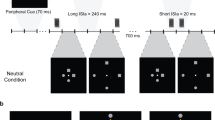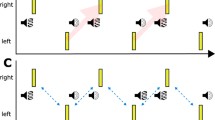Abstract
The coordination of intramodal perceptual grouping and crossmodal interactions plays a critical role in constructing coherent multisensory percepts. However, the basic principles underlying such coordinating mechanisms still remain unclear. By taking advantage of an illusion called temporal ventriloquism and its influences on perceived speed, we investigated how audiovisual interactions in time are modulated by the spatial grouping principles of vision. In our experiments, we manipulated the spatial grouping principles of proximity, uniform connectedness, and similarity/common fate in apparent motion displays. Observers compared the speed of apparent motions across different sound timing conditions. Our results revealed that the effects of sound timing (i.e., temporal ventriloquism effects) on perceived speed also existed in visual displays containing more than one object and were modulated by different spatial grouping principles. In particular, uniform connectedness was found to modulate these audiovisual interactions in time. The effect of sound timing on perceived speed was smaller when horizontal connecting bars were introduced along the path of apparent motion. When the objects in each apparent motion frame were not connected or connected with vertical bars, the sound timing was more influential compared to the horizontal bar conditions. Overall, our findings here suggest that the effects of sound timing on perceived speed exist in different spatial configurations and can be modulated by certain intramodal spatial grouping principles such as uniform connectedness.








Similar content being viewed by others
References
Akselrod M, Herzog MH, Öǧmen H (2014) Tracing path-guided apparent motion in human primary visual cortex V1. Sci Rep 4:6063
Brainard D (1997) The psychophysics toolbox. Spat Vis 10:433–436
Burr D, Banks M, Morrone M (2009) Auditory dominance over vision in the perception of interval duration. Exp Brain Res 198:49–57
Chen L, Shi Z, Müller HJ (2011) Interaction of perceptual grouping and crossmodal temporal capture in tactile apparent motion. PLoS One 6(2):e17130
Cook LA, Van Valkenburg DL (2009) Audio–visual organization and the temporal ventriloquism effect between grouped sequences: evidence that unimodal grouping precedes crossmodal integration. Perception 38:1220–1233
Ekroll V, Faul F, Golz J (2008) Classification of apparent motion percepts based on temporal factors. J Vis 8(4):31. https://doi.org/10.1167/8.4.31
Fendrich R, Corballis PM (2001) The temporal cross-capture of audition and vision. Percept Psychophys 63:719–725
Francis G, Kim H (1999) Motion parallel to line orientation: disambiguation of motion percepts. Perception 28:1243–1255
Freeman E, Driver J (2008) Direction of visual apparent motion driven solely by timing of a static sound. Curr Biol 18:1262–1266
Getzmann S (2007) The effect of brief auditory stimuli on visual apparent motion. Perception 36:1089–1103
Han S, Humphreys GW, Chen L (1999) Uniform connectedness and classical gestalt principles of perceptual grouping. Percept Psychophys 61:661–674
Hidaka S, Teramoto W, Sugita Y (2015) Spatiotemporal processing in crossmodal interactions for perception of the external world: a review. Front Integr Neurosci 9:62
Ho C, Spence C (2008) The multisensory driver: implications for ergonomic car interface design. Ashgate Publishing Limited, Aldershot
Horswill MS, Plooy AM (2008) Auditory feedback influences perceived driving speeds. Perception 37:1037–1043
Kafaligonul H, Stoner GR (2010) Auditory modulation of visual apparent motion with short spatial and temporal intervals. J Vis 10(12):31. https://doi.org/10.1167/10.12.31
Kafaligonul H, Stoner GR (2012) Static sound timing alters sensitivity to low-level visual motion. J Vis 12(11):2. https://doi.org/10.1167/12.11.2
Kawachi Y, Grove PM, Sakurai K (2014) A single auditory tone alters the perception of multiple visual events. J Vis 14(8):16. https://doi.org/10.1167/14.8.16
Keetels M, Stekelenburg J, Vroomen J (2007) Auditory grouping occurs prior to intersensory pairing: Evidence from temporal ventriloquism. Exp Brain Res 180:449–456
Kolers PA (1972) Aspects of motion perception. Pergamon Press, Oxford
Kubovy M, Yu M (2012) Multistability, cross-modal binding and the additivity of conjoined grouping principles. Philos Trans R Soc Lond B Biol Sci 367:954–964
Morein-Zamir S, Soto-Faraco S, Kingstone A (2003) Auditory capture of vision: examining temporal ventriloquism. Brain Res Cogn Brain Res 17:154–163
Olivers CNL, Awh E, Van der Burg E (2016) The capacity to detect synchronous audiovisual events is severely limited: evidence from mixture modeling. J Exp Psychol Hum Percept Perform 42:2115–2124
Palmer S, Rock I (1994) Rethinking perceptual organization: the role of uniform connectedness. Psychon Bull Rev 1:29–55
Pelli D (1997) The video toolbox software for visual psychophysics: transforming numbers into movies. Spat Vis 10:437–442
Recanzone GH (2003) Auditory influences on visual temporal rate perception. J Neurophysiol 89:1078–1093
Roseboom W, Kawabe T, Nishida S (2013) Direction of visual apparent motion driven by perceptual organization of cross-modal signals. J Vis 13(1):6. https://doi.org/10.1167/13.1.6
Sanabria D, Soto-Faraco S, Chan JS, Spence C (2004) When does visual perceptual grouping affect multisensory integration? Cogn Affect Behav Neurosci 4:218–229
Sanabria D, Soto-Faraco S, Spence C (2007) Spatial attention and audiovisual interactions in apparent motion. J Exp Psychol Hum Percept Perform 33:927–937
Shepard RN, Zare SL (1983) Path-guided apparent motion. Science 220:632–634
Shi Z, Chen L, Müller HJ (2010) Auditory temporal modulation of the visual Ternus effect: the influence of time interval. Exp Brain Res 203:723–735
Soto-Faraco S, Kingstone A, Spence C (2003) Multisensory contributions to the perception of motion. Neuropsychologia 41:1847–1862
Spence C (2015) Cross-modal perceptual organization. In: Wagemans J (ed) The Oxford handbook of perceptual organization. Oxford University Press, Oxford, pp 649–664
Spence C, Ho C (2008) Multisensory interface design for drivers: past, present and future. Ergonomics 51:65–70
Takeshima Y, Gyoba J (2013) Complexity of visual stimuli affects visual illusion induced by sound. Vision Res 91:1–7
Ternus J (1926) Experimentelle untersuchungen über phänomenale identität. Psychologische Forschung 7:81–136
Ternus J (1938) The problem of phenomenal identity. In: Ellis WD (ed) A source book of Gestalt psychology. Kegan Paul Trench Trubner & Company, London, pp 149–160
Van der Burg E, Awh E, Olivers CNL (2013) The capacity of audiovisual integration is limited to one item. Psychol Sci 24:345–351
Van der Burg E, Cass J, Alais D (2014) Window of audio–visual simultaneity is unaffected by spatio-temporal visual clutter. Sci Rep 4:5098
Vatakis A, Spence C (2007) Crossmodal binding: evaluating the “unity assumption” using audiovisual speech stimuli. Percept Psychophys 69:744–756
Vroomen J, Keetels MN (2006) The spatial constraint in intersensory pairing: no role in temporal ventriloquism. J Exp Psychol Hum Percept Perform 32:1063–1071
Watanabe K, Shimojo S (2001) When sound affects vision: effects of auditory grouping on visual motion perception. Psychol Sci 12:109–116
Welch RB, Warren DH (1980) Immediate perceptual response to intersensory discrepancy. Psycholo Bull 88:638–667
Wichmann FA, Hill NJ (2001a) The psychometric function: I. Fitting, sampling and goodness-of-fit. Percept Psychophys 63:1293–1313
Wichmann FA, Hill NJ (2001b) The psychometric function: II. Bootstrap-based confidence intervals and sampling. Percept Psychophys 63:1314–1329
Wilbiks JMP, Dyson BJ (2016) The dynamics and neural correlates of audio–visual integration capacity as determined by temporal unpredictability, proactive interference, and SOA. PLoS One 11(12):e0168304
Acknowledgements
We thank Aaron Clarke and Jennifer Corbett for the discussions on this work and comments on the manuscript. This research was supported by the Scientific and Technological Research Council of Turkey (TUBITAK Grant 113K547).
Author information
Authors and Affiliations
Corresponding author
Ethics declarations
Conflict of interest
The authors declare that they have no conflict of interest.
Rights and permissions
About this article
Cite this article
Ogulmus, C., Karacaoglu, M. & Kafaligonul, H. Temporal ventriloquism along the path of apparent motion: speed perception under different spatial grouping principles. Exp Brain Res 236, 629–643 (2018). https://doi.org/10.1007/s00221-017-5159-1
Received:
Accepted:
Published:
Issue Date:
DOI: https://doi.org/10.1007/s00221-017-5159-1




